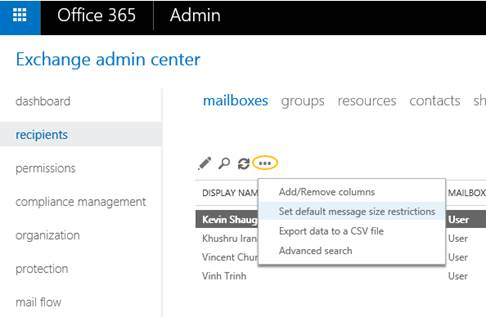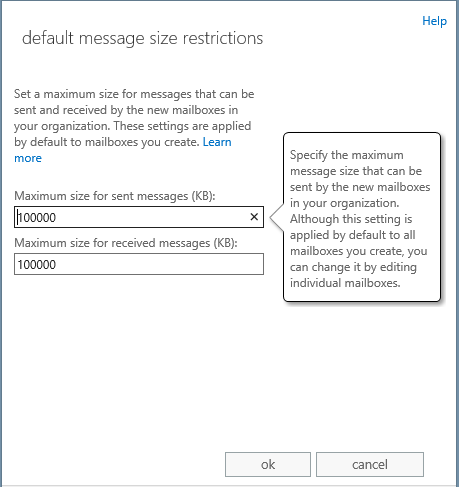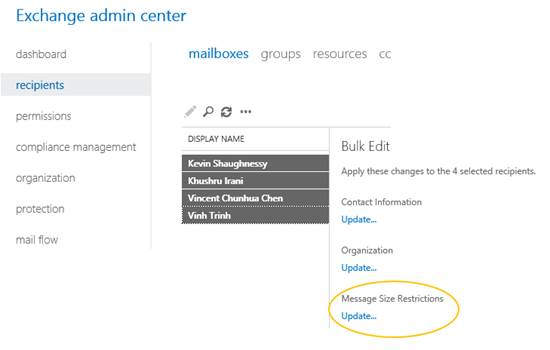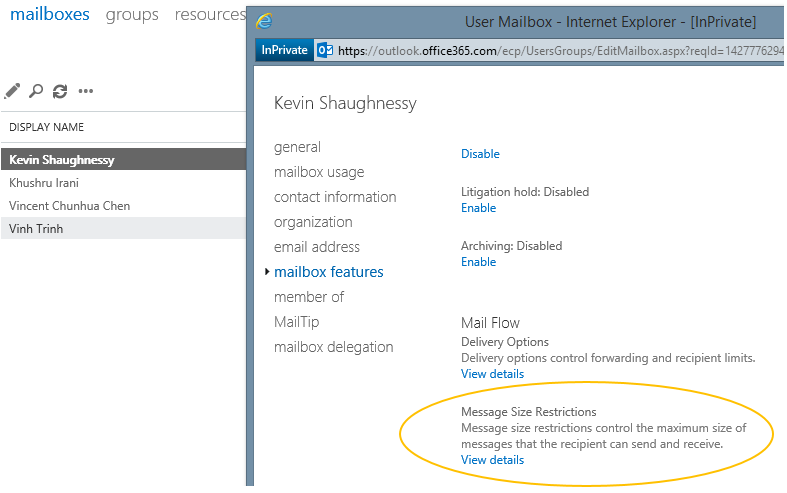
Office 365 now supports larger email messages—up to 150 MB
Updated 12/16/2022: Office 365 is now Microsoft 365. Visit our website to learn more.
For the last few years, the largest email message you could send or receive in Office 365 was 25 MB. While 25 MB is more than enough for the majority of emails, you might bump up against that limit when trying to send large slide decks, spreadsheets, or videos. Outlook Web App (OWA) in Office 365 offers an easy way to “attach” a document as a link to where it’s saved on OneDrive for Business, a great option for sharing large files with your colleagues. But there are times when you’d prefer to send a large file as an actual attachment rather than a link. For those times, we’re pleased to announce that we’ve increased the allowed maximum message size to 150 MB, giving Office 365 administrators the ability to set the maximum message size of their choosing from 1 MB up to 150 MB.
The default maximum message size for Office 365 mailboxes is still 25 MB, and we aren’t going to change the setting on existing accounts. It turns out that some folks want an even smaller setting than 25 MB and many don’t want to change the current setting at all. So instead of us foisting a one-size-fits-all setting onto everyone, we’re now giving Office 365 customers the freedom to choose the maximum size setting that’s right for them.

Microsoft 365
Boost productivity with Microsoft Teams, Word, Excel, PowerPoint, and more—all in one place.
Customizable maximum message size
You can customize the maximum allowed message size for any and all your mailboxes however you see fit. Want to go wild and allow everyone to send and receive 100 MB-size messages? Go for it. Want to restrict students in your school from sending messages larger than 5 MB, while the faculty can send up to 50 MB? No problem. Do you have a hybrid mail configuration (some mailboxes on-premises, some in the cloud), and you want a consistent 10 MB restriction regardless of where the mailbox is hosted? We have you covered. Whatever custom configuration you want to apply, whether for one, some, or all of your mailboxes you can do it—as long as it’s between 1 MB and 150 MB.
You customize the message size in the Exchange Admin Center, which requires global administrator role privileges.
You can change the default for your organization by adjusting the default message size restriction. Simply select recipients > mailboxes then click “. . .” and select Set default message size restrictions.
Microsoft 365 email features and storage
Learn more
You can then specify the maximum message size for new mailboxes (those you create in the future).

To edit multiple mailboxes select recipients > mailboxes and select multiple mailboxes. Then from the Bulk Edit pane under Message Size Restrictions select Update.

Finally, you can customize a single mailbox by selecting recipients > mailboxes and then selecting a user’s mailbox. Click the edit icon, then under Message Size Restrictions, click View details and then specify the maximum message size.

Use the Exchange Admin Center or Remote PowerShell
If your organization is comprised of less than 1,000 mailboxes, you’ll likely end up using the Exchange Admin Center user interface to make changes. But if your organization has more than 1,000 users, you may want to make these changes through Remote PowerShell. Updating thousands of mailboxes at a time can take a while to complete—a rough rule of thumb is around 5 to 10 minutes per 1,000. And while replicating the updates across the service typically takes an additional 15 minutes, allow up to 30 minutes after the update process is finished before testing out the new settings.
Examples of the common commands you might use to customize these settings through Remote PowerShell include:
| ACTION | COMMAND |
| Update a single mailbox | Set-Mailbox -Identity alias@domain.com -MaxSendSize 75MB -MaxReceiveSize 75MB |
| Update multiple mailboxes | (“alias”, “alias2”, “alias3”) | % {Set-Mailbox –Identity $_ -MaxSendSize 75MB -MaxReceiveSize 75MB} |
| Update all mailboxes | Get-Mailbox | Set-Mailbox -MaxSendSize 75MB -MaxReceiveSize 75MB |
| Update the default settings (For mailboxes you create in the future.) | Get-MailboxPlan | Set-MailboxPlan -MaxSendSize 75MB -MaxReceiveSize 75MB |

Microsoft Outlook
Connect, organize, and get things done with free personal email and calendar.
Technical details
There are a few technical details you should know when sending and receiving messages larger than 25 MB.
Personalized email address in Microsoft 365
Learn moreFirst, as the message routes from one mail system to another, it can get larger than when it started. This happens because as a message traverses different mail systems, transcoding (or Base64/MIME conversion) may occur, most commonly between on-premises Exchange and the cloud. This results in a 33 percent larger message than when it left your outbox. Even though the maximum allowed message size is now 150 MB, this is the maximum message size threshold after any potential transcoding has occurred. If your message is going to get transcoded, then it will be limited to 112 MB maximum. Yet, not all messages are subject to transcoding. For example, most messages sent between mailboxes hosted within Office 365 won’t get transcoded, so they can be a full 150 MB in size.
Second, email clients differ in their support for sending large messages. For example, in Outlook, assuming no transcoding is involved, you can attach a 150 MB size file and send it, and assuming the recipient is also hosted in the cloud and is configured to receive 150 MB size messages they’ll receive it. OWA, however, restricts the size of the message you can send to 25 percent less than the configured allowed maximum send size. It does this proactively to account for the possibility there might be a message size increase due to transcoding. For example, if your maximum allowed send size is set to 100 MB then using OWA you can only send up to 75 MB maximum. Additionally, in OWA, each attachment can be no larger than 25 MB. So with a 100 MB maximum send size, using OWA you could attach and send up to three 25 MB files in a single message. These conditions may change in the future, so be sure to check the official Office 365 documentation for the latest on the message size support provided by various email clients.
Lastly, don’t forget that as an Office 365 customer, if you’ve customized your settings to 150 MB, you may be able to send and receive large messages up to 150 MB, but your associates may not. Whether it’s because their mail is hosted on a different email service or system that doesn’t support large message sizes, or they’re an Office 365 user but haven’t changed their settings, they may not be able to receive your large message. So if your message is over 25 MB be sure to ask them about it in advance before sending it to them.
Learn more
Leverage Microsoft 365 today.
Explore additional resources:
- Compare Microsoft 365 plans.
- Changes to Microsoft 365 email features and storage.
- Get a personalized email address in Microsoft 365.
